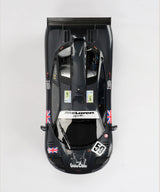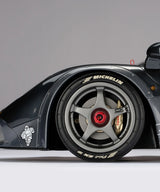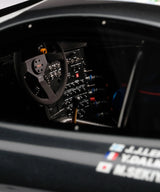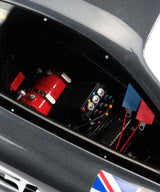It was perhaps inevitable, given not just McLaren’s raison d’être but also Gordon Murray’s professional background and expertise, that the McLaren F1 road car would eventually take to the racetrack, even though Ron Dennis had specifically denied such a possibility when the car was launched. Murray had no such plans either. He merely dreamed of building what was quickly and widely to become recognised as the 20th century’s most exotic road car, and at the conclusion of a three-year design-and-build process he had achieved exactly that.
Before long, however, customers were asking for a racing version, and as the 1995 GT season drew nearer the number of requests began to climb. After much persuasion, Murray agreed to produce nine chassis, some in time for the 1995 edition of Le Mans. As the F1 was based directly on McLaren’s racing experience, little in the way of track modifications needed to be carried out. The F1 GTR was, in fact, slightly less powerful than the road going variant due to regulations limiting cars to 600bhp. The F1 GTRs also had to be fitted with steel roll-cages, the steering rack ratios were quicker, and the rubber bushing in the suspension was removed. Development of downforce was limited to a single day in the wind-tunnel under Murray’s direction, while the OZ Racing wheels concealed even larger discs and callipers.
The F1 GTR quickly wrote its name into the record books, with victory at the 1995 edition 24 Hours of Le Mans against faster, purpose-built prototypes. Seven F1 GTRs entered the race, and five finished: taking first, third, fourth, fifth and thirteenth places, an incredible showing for what was essentially a road car. The victory marked some highly significant motorsport firsts: McLaren had won Le Mans at its first attempt; the F1 GTR had won the event in its first year of production, and not even Ferrari had managed that; it was also the first Le Mans win for a Finnish driver, and for a Japanese one, as well as being a first for BMW power. As if that wasn’t enough, the F1 GTR also went on to win the 1995 Global GT Championship. The cars were not only fast, but consistent. The championship-winning car of Thomas Bscher and John Nielsen won only two races that year but was nevertheless sufficiently reliable throughout the season to amass the necessary points to take the title. The greatest supercar of its generation had been transformed into the most successful British sports racing car of modern times.
This fine 1:8 scale model of the McLaren F1 GTR is of the Ueno Clinic sponsored #59 car that emerged victorious at the 24 Hours of Le Mans in 1995; it was a legendary and shocking victory against the purpose-built and much faster prototypes. The car itself was a development chassis, named 01R, entered at the last minute for the Kokusai Kaihatsu Racing team, who needed a car after originally being allocated 08R, which was instead used to replace a Gulf that had been crashed heavily in an accident at the 4 Hours of Jarama. By any standards, the 1995 race was an epic. The weather was appalling – it rained for 16 of the 24 hours – but the trio of Yannick Dalmas, Masanori Sekiya and JJ Lehto impressed, particularly the latter whose relentless pace saw him posting lap-times up to 20 seconds faster than his rivals. The #59 car crossed the finish line one whole lap ahead of the Courage C34 prototype of Mario Andretti, going down in folklores of Le Mans history as one of the greatest stories. 01R has remained in the ownership of McLaren ever since and is proudly displayed on the Boulevard at the McLaren Technology Centre.
This model has been handcrafted and finished in our workshops with the co-operation and assistance of McLaren Automotive regarding original finishes, materials, archive imagery and drawings. The use of supremely accurate digital scanning of the original car has allowed us to perfectly recreate every detail at scale. Furthermore, it has undergone detailed scrutiny by both McLaren's engineering and design teams to ensure complete accuracy of representation.
















